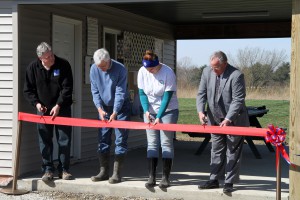Biology students conduct research in new structure built by construction trades students
(Click HERE for a short video of the ribbon cuttig ceremony and demonstration.)
 Lincoln Land Community College cut the ribbon yesterday on a new structure that will house the college’s bird banding research program. In cooperation with the Lincoln Land Association of Bird Banders, LLCC biology students participate in the capture, banding and release of birds, recording information which is added to a massive data pool on bird migration patterns.
Lincoln Land Community College cut the ribbon yesterday on a new structure that will house the college’s bird banding research program. In cooperation with the Lincoln Land Association of Bird Banders, LLCC biology students participate in the capture, banding and release of birds, recording information which is added to a massive data pool on bird migration patterns.
The 36’ by 24’ building with a porch and overhang was built by LLCC construction trades students, a program funded through the Illinois Department of Transportation.
Cutting the ribbon were LLCC Trustee and Board Secretary Dennis Shackelford, LLCC Biology Professor Tony Rothering, Lincoln Land Association of Bird Banders (LLABB) President Vern Kleen, and LLCC bird banding student Lizzie Roehrs.
Professor Rothering and Mr. Kleen began the program in fall of 2012 on the northeast edge of the LLCC campus and to date, approximately 11,000 birds representing 113 species have been banded. LLABB members, school groups and organizations also participate in banding activities. Until the new structure was built, all bird banding took place outside and was cancelled during inclement weather. Banders can now do research inside when needed during the fall and spring banding seasons.
Speaking at the ribbon cutting, Rothering thanked the LLCC Board of Trustees, college administrators, LLABB and the construction trades program for support on the project. He noted the significance of the collected data on international weather and climate change research.
“The LLCC bird banding station provides students with a practical scientific experience outside of the classroom,” said Rothering. “Our hands-on approach allows students to appreciate the biological importance of studying bird population and migration patterns and how they relate to the greater ecological world.”

